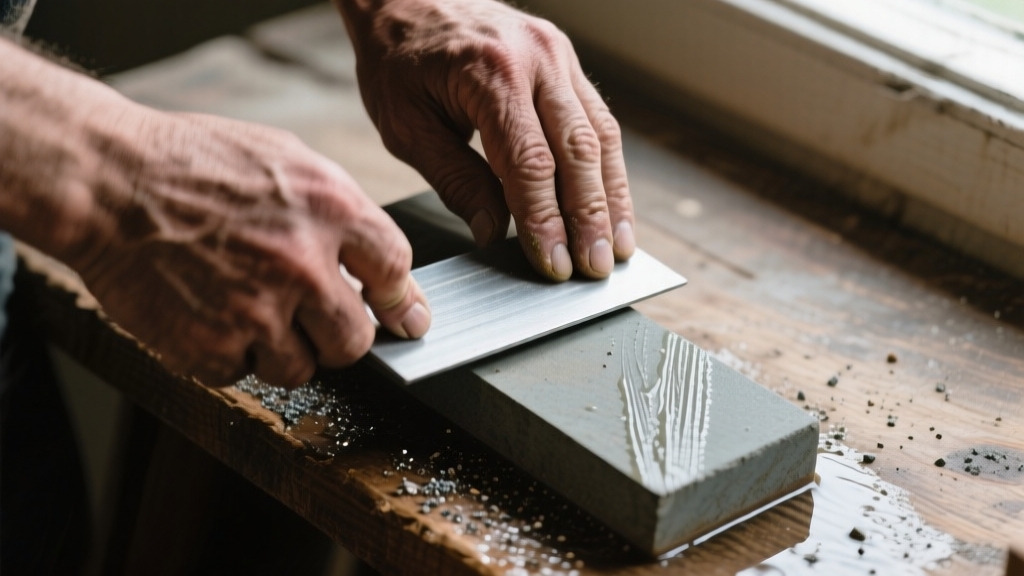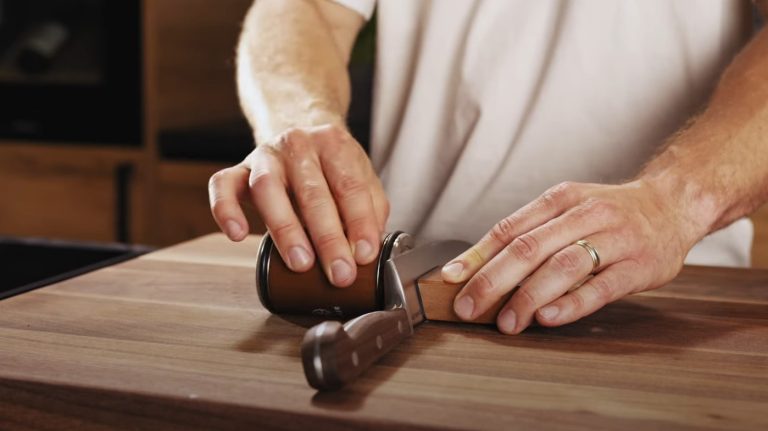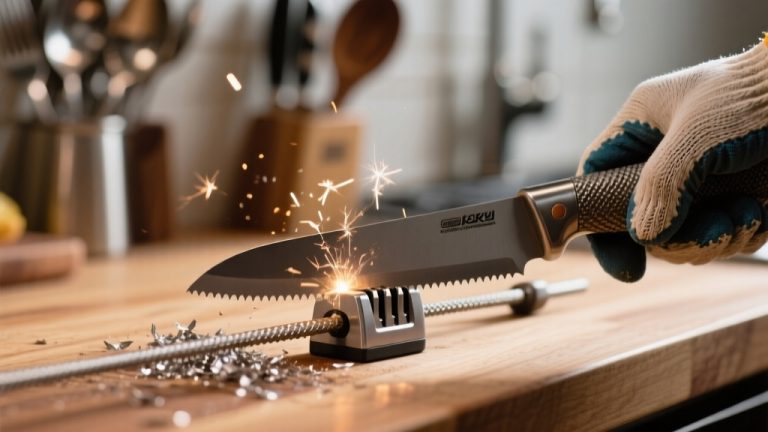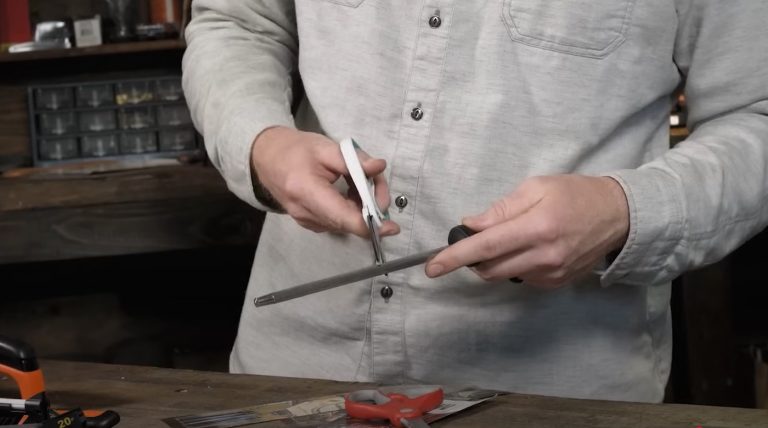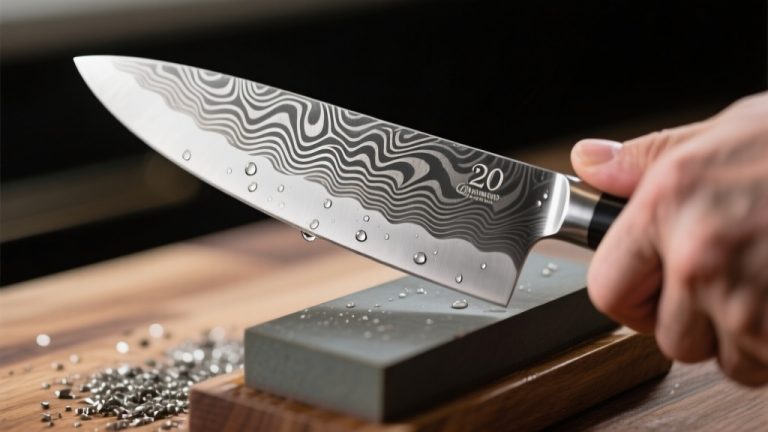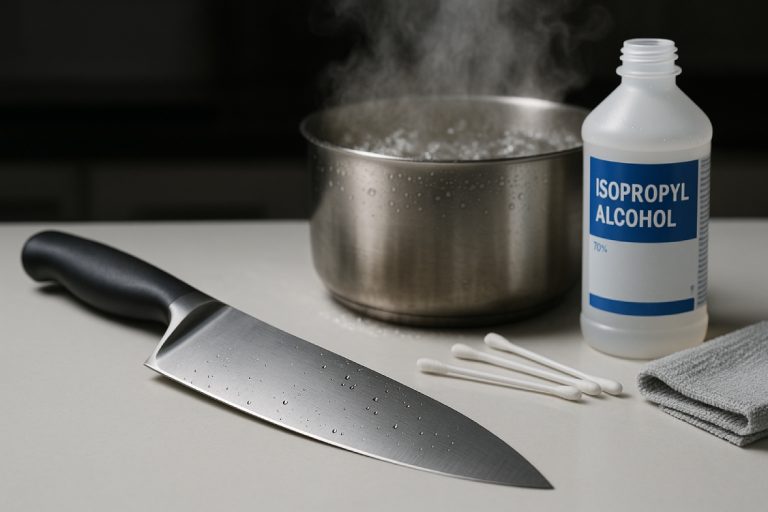How to Flatten a Whetstone the Right Way?
To flatten your whetstone, soak it if it’s a water stone, then secure a diamond or coarse flattening stone on a stable surface.
Mark your whetstone with pencil lines to track wear. Use consistent, even pressure and move the whetstone back-and-forth or in circles across the flattening tool, keeping both surfaces wet.
Flatten until the pencil marks fade evenly, ensuring a flat surface for ideal sharpening. Proper technique and timing keep your stone effective and durable—there’s more to mastering this process.
Key Takeaways
- Soak water stones for 10–20 minutes before flattening to saturate and prevent clogging; oil stones require cleaning but no soaking.
- Mark the stone surface with a pencil grid to identify uneven wear and monitor flattening progress.
- Use a diamond flattening stone, lapping plate, or sandpaper on flat glass with wet, even back-and-forth or circular strokes.
- Apply consistent, moderate pressure while flattening, keep the stone wet, and rinse often to avoid clogging and ensure even abrasion.
- Continue flattening until pencil marks fade uniformly, then slightly taper edges to reduce chipping and maintain stone longevity.
Causes and Signs of Whetstone Dishing

Although whetstones are designed for durability, you’ll notice dishing occurs as abrasive particles wear the surface unevenly during sharpening.
Uneven or excessive pressure and inadequate lubrication accelerate this localized wear, especially on coarser grit stones. Using the correct sharpening angle helps minimize uneven wear and prolongs stone life.
Natural and water stones are more prone to dishing due to their material properties and absorption characteristics.
You’ll spot dishing by visual hollows, pooling water or oil, and trouble maintaining a consistent sharpening angle.
This leads to uneven edge geometry and longer sharpening times.
Regularly inspect your stone for concave indentations or liquid accumulation.
Watch for inconsistent blade wear or difficulty holding angles, which indicate uneven contact.
Maintaining flatness is crucial for optimal sharpening results, as flat whetstones ensure better sharpening performance and safety.
Recognizing these causes and signs early helps you maintain precision and prolong stone and blade life. Regular maintenance also supports the edge retention of stainless steel knives, ensuring optimal sharpness.
Tools and Materials Needed for Flattening
Spotting dishing early helps you take timely action to restore your whetstone’s flatness. To do this effectively, you’ll need the right tools and materials tailored to your whetstone type and budget. Here’s a quick overview:
| Tool/Material | Key Features |
|---|---|
| Diamond Flattening Stone | Durable, fast-cutting, requires wetting |
| Truing Stone | Designed for flattening, wet use preferred |
| Sandpaper on Flat Glass | Cost-effective, coarse grit, requires moistening |
| Concrete/Paver Blocks | Readily available, variable flatness |
| Silicon Carbide Plates | Professional use, highly abrasive |
Each tool removes high spots differently, but all require wetting to prevent clogging and ensure even flattening. The diamond flattening stone is especially effective for quickly restoring worn or hollowed water stones to optimal flatness.
Choose based on availability, cost, and whetstone type for best results. Using tools with interchangeable abrasive surfaces can enhance efficiency and precision during flattening.
Preparing Your Whetstone and Flattening Tool
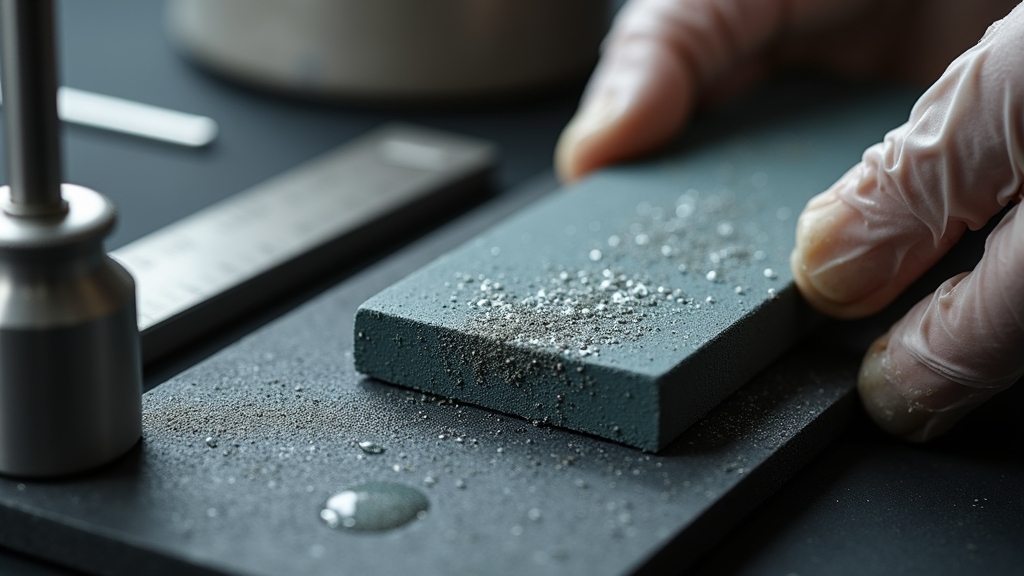
Before you dive into flattening your whetstone, it’s a good idea to soak it in water for about 5 to 10 minutes. This ensures that the stone is fully saturated, which helps reduce friction and makes it easier to wash away any debris that builds up during the process. Using a water-saturated whetstone also helps prevent uneven wear during flattening.
Now, once your whetstone is nice and soaked, you’ll want to choose the right flattening tool. You typically have a couple of options here—either a coarse flattening stone or a diamond plate will do the trick.
These tools are designed to effectively level out your whetstone’s surface, making sure it’s ready for your sharpening tasks. It’s important to select a flattening stone that matches your whetstone’s grit, such as pairing coarse stones with coarse flattening stones or fine stones with fine flattening stones.
Soaking the Whetstone
When you soak your whetstone, you fully saturate its porous surface to guarantee effective sharpening and protect your knife’s edge from damage. Submerge your waterstone in clean water for 10 to 20 minutes, depending on grit.
Coarse stones need 15 to 20 minutes, medium 10 to 20, and fine just 5 to 10 minutes. Watch for escaping air bubbles; soaking is complete when they stop. Regular maintenance of your sharpening tools ensures consistent results and prolongs their usability.
This saturation prevents the stone from drawing moisture from the blade, avoiding edge damage. It also provides lubrication to reduce friction and swarf buildup. Proper soaking improves the smoothness of sharpening and blade glide, enhancing overall sharpening efficiency sharpening efficiency.
Keep water nearby during sharpening to maintain moisture. Avoid soaking stones not designed for immersion, such as resinoid or magnesia types, as they can weaken or crack. Using inappropriate stones can lead to blade edge damage and reduce sharpening effectiveness.
Choosing Flattening Tools
Although flattening your whetstone is essential for maintaining its effectiveness, choosing the right flattening tool guarantees the job is done efficiently and accurately.
Diamond flattening plates are ideal for quick, precise flattening due to their superior hardness, durability, and consistent flatness.
If you prefer a budget option, silicon carbide stones offer effective stock removal but wear faster.
Ceramic truing stones work well for soft water stones, while combination dual-grit stones let you switch between coarse and fine flattening.
Always pick a tool with coarse grit to remove unevenness quickly, and assure it’s harder than your whetstone for effective cutting. Regular maintenance, including flattening, ensures sharp knives improve kitchen safety.
Tools backed by metal plates provide stability, and those with grooved surfaces facilitate debris removal, improving the flattening process and extending tool life.
Since synthetic stones are man-made with bonded abrasives, flattening tools often utilize similar materials to enhance compatibility and efficiency in reshaping the whetstone surface.
Step-by-Step Flattening Instructions
To begin, make sure your whetstone and flattening tool are ready to go. It’s important that both surfaces are clean and moistened, plus you’ll want to secure them in place. A little tip: grab a pencil and mark your whetstone with a crosshatch pattern.
This will help you keep track of any uneven areas as you work—it’s a handy trick! Regular maintenance prevents uneven wear and ensures your stone remains effective. Using the right sharpening angles during flattening can also improve the overall sharpening performance.
Next, it’s all about using a consistent flattening technique. Apply even pressure as you go along, and don’t forget to check your progress regularly.
Preparing the Surfaces
Before flattening your whetstone, guarantee its surface is thoroughly prepared by soaking or wetting it appropriately, depending on the stone type.
Water stones need soaking for 10 to 20 minutes to saturate and aid slurry formation. Oil stones require cleaning without soaking.
Keeping the stone wet during use prevents clogging and maintains efficiency.
Next, stabilize your setup by placing the whetstone on a non-slip base and a flat surface at a comfortable height.
Finally, assess the stone surface by marking it with an oil-based pen to identify uneven areas. This visual guide helps target high and low spots during flattening for precise resurfacing.
- Soak or wet the stone correctly
- Secure the stone on a stable, non-slip surface
- Mark the stone to identify wear patterns
It is also important to dry the whetstone completely after flattening to prevent moisture-related damage and prolong its lifespan.
Flattening Technique Steps
Once you’ve properly marked your whetstone, you can begin flattening by placing a coarser flattening stone or lapping plate on its surface. Move it in back-and-forth or circular motions with moderate, even pressure, focusing on high spots.
It is important to maintain water saturation on the stone during the process to ensure effective abrasion and prevent clogging. Using a flattening stone with the right grit size can significantly improve the efficiency of the flattening process.
Keep the flattening stone wet and rinse often to avoid clogging. Continue until pencil marks fade uniformly, indicating flatness.
| Step | Action |
|---|---|
| 1 | Mark stone with pencil crosshatch |
| 2 | Place coarse flattening stone |
| 3 | Move stone evenly, moderate pressure |
| 4 | Keep stone wet, rinse frequently |
| 5 | Stop when marks disappear evenly |
Maintaining the Edges of Your Whetstone

Although maintaining the sharpness of your blade is essential, preserving the edges of your whetstone guarantees consistent performance and longevity.
The stone’s edges are prone to chipping and uneven wear, which can compromise sharpening quality. To maintain your whetstone edges effectively:
- Slightly taper the edges after flattening to reduce chipping risks during sharpening.
- Flip and rotate the whetstone regularly to distribute wear evenly and prevent localized edge damage. This practice is similar to using diamond abrasives to refine edges evenly during knife sharpening.
- Avoid excessive flattening near edges; focus on light maintenance to preserve integrity without premature wear. Regular upkeep is essential for optimal sharpening performance, as it helps maintain the stone’s effectiveness over time regular upkeep.
Frequency and Timing for Flattening Sessions
Since the wear rate of your whetstone depends on factors like grit size, usage frequency, and stone composition, you’ll need to adjust flattening intervals accordingly.
Coarser stones (220–2000 grit) require flattening after every two to four knives.
Finer stones (3000 grit and above) can go longer, typically five to ten knives.
Frequent sharpening or working on damaged edges demands more regular flattening to prevent concave wear, which complicates truing and reduces efficiency.
Use visual cues like visible dish, uneven sharpening, or pencil mark tests to time sessions.
Flatten often to maintain consistent bevel contact, sharpening speed, and surface integrity.
This practice maintains consistent sharpening angles and prevents angle variation caused by dishing, ensuring better sharpening results.
Regular maintenance like this complements the use of whetstones and butchers steel for optimal knife edge longevity.
Alternative Methods for Flattening Whetstones
Maintaining your whetstone’s flatness doesn’t have to rely solely on traditional methods like lapping with a coarse stone. You can explore alternative approaches that suit your needs and budget.
Explore practical alternatives to traditional whetstone flattening that fit your needs and budget.
Consider these options:
- Diamond Lapping Plates – Durable and efficient, these plates quickly flatten stones with grit sizes around 325-400. They’re reusable and ideal for frequent sharpening routines. Regular flattening with a diamond plate prevents grooves and uneven surfaces that impair sharpening reliability.
- Sandpaper on Flat Substrate – Attach coarse sandpaper (around 150 grit) to polished glass or granite. Wetting both surfaces reduces slurry, helping you address minor unevenness cost-effectively.
- Cinder Blocks or Concrete – A low-cost, rough surface option that works outdoors or for budget setups. Clean the block well, but expect slower flattening and occasional flatness checks. Tests have shown that a cinder block does not achieve the same flatness as a diamond plate.
Each method offers unique advantages, letting you tailor your flattening technique to your stone’s condition and your sharpening frequency.
Tips for Efficient and Safe Flattening
When you flatten your whetstone, controlling your movement technique is essential for even wear and ideal results. Use vertical back-and-forth strokes combined with straight and circular motions to ensure symmetrical flattening. This vertical motion promotes a uniformly flat surface for better sharpening.
Move the leveling stone across the longest distance of the whetstone, varying directions to avoid uneven wear. Apply light, consistent pressure throughout to protect both stones and prevent concave or convex surfaces. Consistent technique enhances flattening efficiency and helps maintain flatness.
Avoid placing the stone at awkward angles that cause deformation. Prepare by drawing a pencil grid to monitor progress and use water to form slurry, enhancing abrasion and debris removal. Maintaining flatness prevents uneven wear for effective sharpening.
Secure your flattening surface to maintain stability and keep the workspace wet and clean. Regular, modest flattening sessions after sharpening a few knives will prolong both whetstone and blade life safely and efficiently. Regular flattening is essential to maintain an optimal sharpening surface.
Troubleshooting Common Flattening Issues
Although flattening your whetstone may seem straightforward, common issues like uneven wear, surface imperfections, and texture changes can hinder its effectiveness.
To troubleshoot:
1. Identify uneven wear by marking a grid with a pencil on the stone. Dark patches reveal hollows needing more flattening. Avoid overusing edges to prevent chips and rapid wear. Regular flattening maintains effective contact between the stone and blade, ensuring consistent sharpening results.
22. Use proper technique**. Employ circular motions covering the entire surface with a coarser grit flattening tool**. Infrequent or light pressure flattening won’t correct hollows effectively.
3. Monitor texture changes. If your stone feels smoother and slows cutting, it may have lost abrasive grit. Cleaning helps but replacement might be necessary.
Frequently Asked Questions
Can I Use a Whetstone for Sharpening Other Tools Besides Knives?
Yes, you can use a whetstone to sharpen other straight-edged tools like garden shears, chisels, and axes, as long as their bevel angles match your stone’s grit.
Just adjust your sharpening angle and technique accordingly. Remember, whetstones work best on metal blades without serrations or complex shapes.
For very hard steels, synthetic or diamond stones might be better. Always keep your stone flat for consistent results across different tools.
How Do I Store My Whetstone to Prevent Damage or Drying Out?
Store your whetstone like a delicate flower, keeping it cool and dry away from direct sunlight to prevent cracking.
Always dry it thoroughly after use, air-drying naturally in the shade.
Avoid stacking stones or trapping them in plastic; instead, wrap in breathable cloth and place in ventilated wooden or plastic boxes.
Regularly check for cracks and clean grit off the surface.
This care preserves your whetstone’s integrity and sharpening performance.
Is It Safe to Share My Whetstone With Others for Sharpening?
Sharing your whetstone isn’t entirely safe unless you clean it thoroughly after each use.
Metal particles, oils, and bacteria can transfer between users, increasing contamination and infection risks.
Always wash the stone with water and a soft brush, flatten it regularly, and consider wearing gloves to minimize skin contact.
For best safety and hygiene, avoid sharing without proper cleaning, or better yet, provide personal stones to each user.
Can Flattening a Whetstone Affect the Grit or Sharpening Quality?
You know what they say: “A stitch in time saves nine.” Flattening your whetstone won’t change its grit but keeps its surface even, ensuring consistent sharpening quality.
If you flatten too aggressively, you might wear finer grits prematurely, slightly altering texture.
Done right, it removes uneven wear, improves edge precision, and maintains grit effectiveness.
Frequent, gentle flattening preserves your stone’s performance and sharpens your blades reliably every time.
Are Electric Flattening Devices Effective Compared to Manual Methods?
Electric flattening devices are highly effective if you need speed and uniformity, especially for frequent use.
They quickly restore flatness with minimal effort, but you risk over-flattening or damaging the stone if you’re inexperienced.
Manual methods give you better control and cost less, but they’re slower and require more effort.
If you sharpen occasionally, manual flattening might suit you better, while professionals benefit more from electric devices.
Ready to Keep Your Whetstone Flat and Efficient?
Regularly flattening your whetstone is essential, as studies show that a dished stone can reduce sharpening efficiency by up to 40%.
By following the steps outlined, you’ll maintain a perfectly flat surface, ensuring your blades stay sharp and your sharpening sessions remain effective.
Remember, consistent care not only prolongs your whetstone’s lifespan but also guarantees precise, safe sharpening every time.
Keep your tools in top shape with regular flattening; it truly makes a difference.

